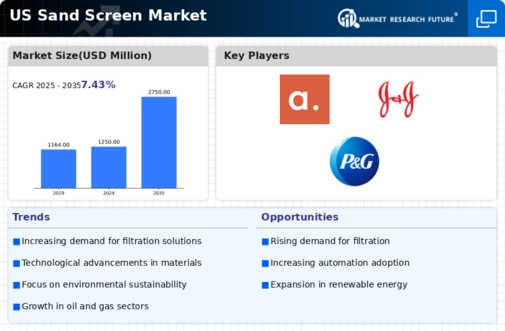Rising Demand for Oil and Gas
The sand screen market is experiencing a notable surge in demand driven by the oil and gas sector. As exploration and production activities intensify, particularly in shale formations, the need for effective sand control solutions becomes paramount. In 2025, the US oil production is projected to reach approximately 12 million barrels per day, necessitating advanced sand screen technologies to enhance well performance and longevity. This trend indicates a robust growth trajectory for the sand screen market, as operators seek to mitigate sand production issues that can lead to costly operational disruptions. The increasing complexity of extraction processes further emphasizes the importance of reliable sand screen solutions, positioning the market for sustained expansion.
Increased Regulatory Compliance
The sand screen market is significantly impacted by the evolving regulatory landscape in the US. Stricter environmental regulations aimed at minimizing the ecological footprint of oil and gas operations are prompting companies to adopt advanced sand control technologies. In 2025, it is estimated that compliance costs for operators could rise by 15%, pushing them to invest in efficient sand screen solutions that meet regulatory standards. This trend indicates a shift towards more sustainable practices within the industry, as companies seek to balance operational efficiency with environmental responsibility. Consequently, the sand screen market is likely to benefit from increased investments in innovative technologies that comply with these regulations.
Growth in Renewable Energy Projects
The sand screen market is also influenced by the expansion of renewable energy projects, particularly in wind and solar energy sectors. As the US government pushes for a transition to cleaner energy sources, investments in infrastructure are expected to rise. In 2025, renewable energy is anticipated to account for over 30% of the total energy generation in the US. This shift necessitates the use of sand screens in various applications, including the construction of wind turbine foundations and solar panel installations. The integration of sand screen technologies in these projects not only enhances structural integrity but also aligns with sustainability goals, thereby driving demand within the sand screen market.
Technological Innovations in Sand Control
The sand screen market is experiencing technological innovations that enhance sand control solutions. Advancements in materials science and engineering are leading to the development of more durable and efficient sand screens. In 2025, the introduction of smart sand screen technologies, which utilize sensors and data analytics, is expected to revolutionize the market. These innovations allow for real-time monitoring of sand production, enabling operators to make informed decisions and optimize well performance. As the industry increasingly embraces digital transformation, the demand for technologically advanced sand screen solutions is likely to grow, positioning the market for substantial growth in the coming years.
Expansion of Hydraulic Fracturing Activities
The sand screen market is linked to the expansion of hydraulic fracturing activities across the US. As operators seek to maximize production from unconventional resources, the use of sand screens becomes critical in managing proppant flowback and ensuring well integrity. In 2025, hydraulic fracturing is projected to account for over 70% of the total oil and gas production in the US. This trend underscores the importance of effective sand control measures, as the industry grapples with challenges related to sand production. Consequently, the sand screen market is poised for growth, driven by the increasing reliance on hydraulic fracturing techniques and the need for reliable sand screen solutions.














Leave a Comment